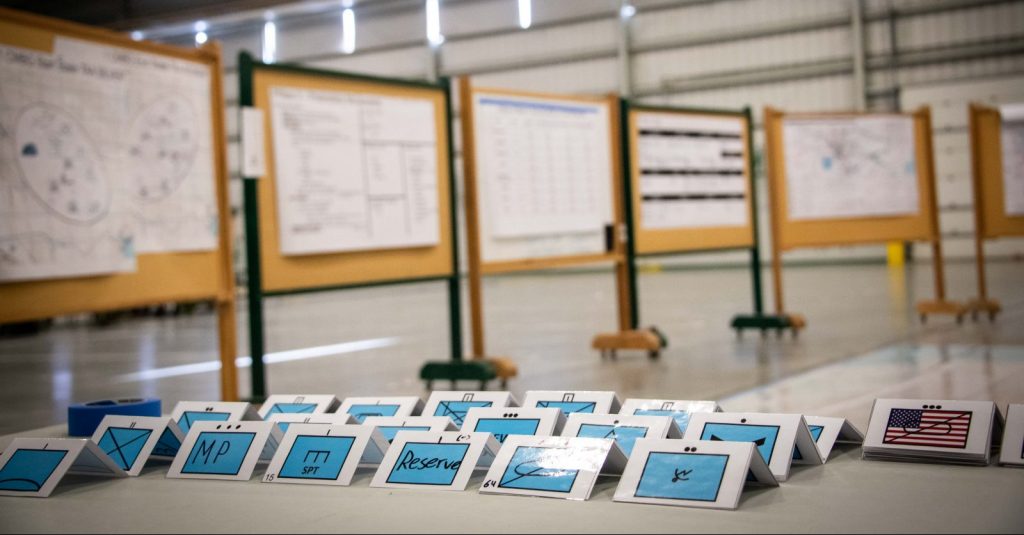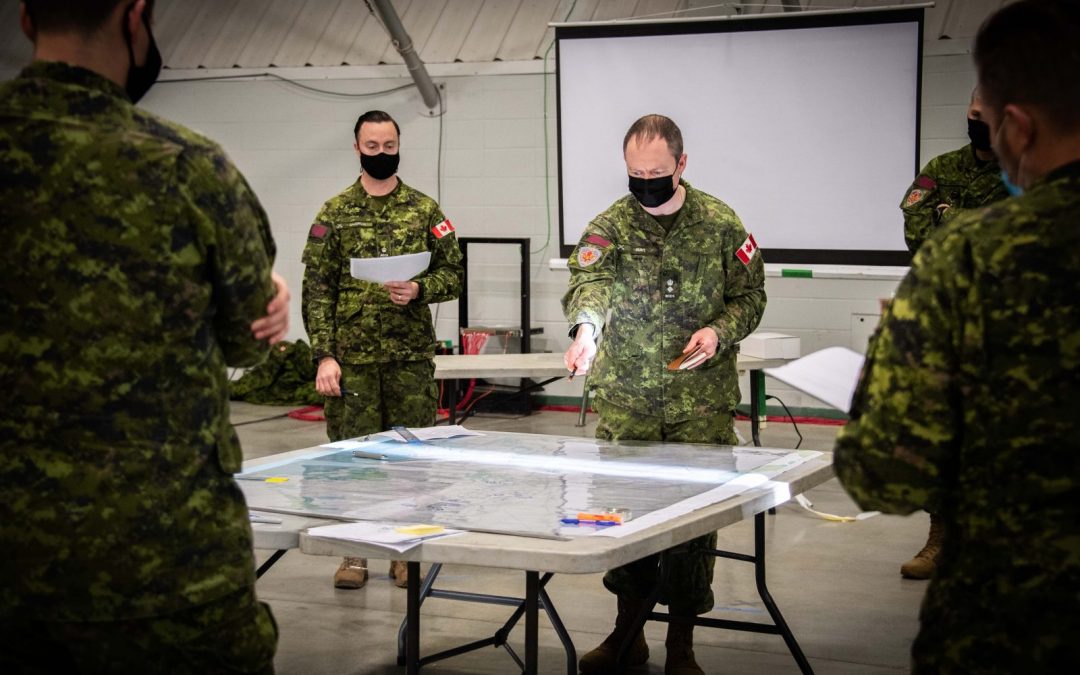by Chris Thatcher
As the Canadian Army’s largest computer-assisted training event, Exercise Unified Resolve often requires a year of planning to construct the scenario, develop the injects, secure the network and coordinate the movement of troops and contracted support from across the country to deliver a complex challenge to a large training audience.
Lieutenant-Colonel Shane Gifford was just starting to get his head around the problem when the reality of trying to deliver it in the midst of a global pandemic set in.
The exercise director with the Canadian Manoeuvre Training Centre, this was going to be his third Ex Unified Resolve. It should have been relatively routine. COVID-19 ensured it was anything but.
Though mitigating the pandemic was a constant factor throughout the planning process, provincial and municipal health regulations kept changing in the months leading up to the exercise in early February. “It was always difficult to predict where things were going to head, so we had to adapt the exercise on the fly,” said Gifford.
Though Unified Resolve (UR) has often incorporated units from dispersed locations, most of the training audience, supporting role players and exercise control are located in one location. In 2021, dispersion became the watchword. The primary training audience (PTA), 1 Canadian Mechanized Brigade Group (CMBG) headquarters and some of its subunit headquarters, remained in Edmonton, Alta., while the higher control headquarters, played by 1st Canadian Division, participated from Kingston, Ont., and the flanking brigades, role-played by members from 5 CMBG in Valcartier, Que., and 2 CMBG in Petawawa, Ont., connected from their home bases.
The Canadian Army Simulation Centre, which normally orchestrates the exercise from a facility adjacent to the PTA, remained in Kingston. And a unit from the Canadian Combat Support Brigade traveled from Gagetown to test-drive its new operating concept for delivering electronic warfare, ISR, intelligence and other enabling functions to the Division.
While planning had picked up in earnest over the summer as health regulations were easing, by late fall most provinces were bracing for a second wave of COVID cases. When the exercise began on January 31, Ontario was under a stay-at-home order, Quebec had declared a nighttime curfew and Alberta was restricting all gatherings. Unified Resolve was classified as essential training, but participants would still have to navigate local rules.
“It became clear it was going to be very difficult to come up with a one-size-fits-all solution,” Gifford said. “We eventually defaulted to the rules that were extant in each location.”
After consultation with the commander of the Canadian Army Doctrine Training Centre, Major-General Michel-Henri St-Louis, the exercise team made two significant changes: First, the number of participants was scaled back, including supporting contractors; and, as a result of that, the exercise was reduced from 24 hours per day over the six days to just 12 hours each day, from 0700 to 1900, which eliminated an entire nightshift of military and supporting personnel.
“We took a 30 to 40 percent appetite suppressant on the number of people while still meeting the training objectives for the exercise,” said Gifford. Unified Resolve 2019 had almost 1,500 participants concentrated in a few locations; in 2021, the total was 727, split between Edmonton (296), Kingston (230) and Valcartier (201).
Though Gifford and the exercise team did not know it at the time, the exercise in 2020 had provided them a dry run for what was to come. Capitalizing on the Army’s emerging training network, UR20 had involved over 900 participants distributed across three locations in Petawawa, Kingston and Valcartier. Resolving the technology challenges then helped inoculate the team in 2021.
“It certainly told us what we needed to focus on in terms of preparation prior to the exercise,” he said. “We spent more time this year ensuring that the communications network was up and running prior to pushing go on the actual exercise. A lot of effort went into making sure our command and control system, the Land Command Support System, was working properly, with enough time to work out any bugs. That was a lesson learned from last year.”

LCol Wade Rutland (left), commander of 1 CMBG, during Ex Unified Resolve 2021 in Edmonton. Photo: MCpl Alexandre Paquin
THE EX MUST GO ON
With all regions of the country affected by the pandemic, some questioned the wisdom of holding a large collective exercise, even with members dispersed across multiple locations. Colonel Wade Rutland, commander of 1 CMBG, acknowledged the rumblings but argued “turning off” yet another exercise wasn’t really an option – the Army’s readiness had already been significantly impacted by cancelling Maple Resolve, its largest confirmation exercise, in May 2020.
“I think we’ve come to realize that you can’t just shut down operations and training in this environment, because our adversaries haven’t,” he said. “The Canadian public still expects us to provide safety and security and if the call comes, they are not going to accept that we shut down because of COVID.”
The ripple effect of cancelling one major exercise in the Army’s three-year high readiness rotation means that a brigade’s personnel might not get a similar opportunity for three years. “You don’t lose a year, you lose a generation of years,” Rutland stressed. “To miss a year of this cycle is really detrimental to the institution.”
Lieutenant-General Wayne Eyre, at the time the Army Commander, suggested exercises like Unified Resolve and Maple Resolve were precisely the reason why the Army has been able to respond quickly to provincial calls for assistance in long-term care facilities and northern communities. “Our ability to operate in these emergencies comes from years of practice on these different types of exercises. The ability to face complexity, large scale operations, to add structure to chaos – that’s what our planners are doing at the Public Health Agency of Canada right now. Our readiness is based on these exercises.”
The brigade had resumed individual training late last summer and each unit had completed a major field exercise in the fall, all with zero cases of COVID, so Rutland felt confident his headquarters and units had adapted to health measures such as mask wearing and “creative ways to do things.” Still, UR21 was different.
“It is hard to communicate with a mask on. It’s hard to project your voice. We can’t have as many people in, say, orders groups or rehearsal drills, just because of spacing,” said Rutland, who previously participated in UR16 and UR19. “But we found ways to adapt or just accept the kind of inefficiencies inherent in operating in that environment.”
Headquarters functions and brigade subunits were located in separate rooms, with designated washrooms and separate meals delivered every morning, limiting interaction. In Kingston, where the exercise control, divisional headquarters and other elements would normally operate from a common space, each had a separate room.
Fewer participants and a different structure might have lessened some of the realism and friction found in previous Unified Resolve exercises, but it did not reduce the training value, Rutland noted. “One of the things about a crisis is that you often have to look at things with a fresh set of eyes. I think we actually made a lot of great progress in Unified Resolve because of some of the mitigation measures.”
If the exercise is normally an intense six-day blur of around-the-clock operations, testing endurance as battle fatigue sets in, then the switch to a 12-hour day created a better opportunity to learn. An after-action review (AAR) often occurs midway through the exercise, while participants are still in the thick of the fight. This time, the AAR took place at the end of each day.
“Normally you’re thinking about getting right back into it and because the pace is so high, you don’t get a chance to implement some of the fixes you identify,” he said. “[This time] you could really focus on that after-action review and then immediately put into effect your fixes the very next day. We found we made great progress on our identified [AAR] points. I don’t know if that was just a side benefit of this, but it certainly allowed us to focus on learning and getting better.”
The usual sleep depravation and loss of information generated by shift changes affected some of the realism, and the 12-hour day meant the exercise resumed where it had left off the day before and keeping track of time became a test in and of itself. “There are definitely advantages to the 24-hour model – that is the way we will fight,” he added. “In future exercises, perhaps we will be able to take some of the good learning points from this iteration, such as more frequent AARs, to make the overall exercise the highest-value training experience possible.”

Photo: MCpl Alexandre Paquin
LESSONS FROM THE BOX
The primary objective of Unified Resolve is to validate the brigade headquarters and some of its unit commands for global deployment. Under recent changes to the Managed Readiness Plan, 1 CMBG is one of two brigade groups along with 2 CMBG on the road to high readiness in 2020-21. It will become a contingency force, ready for deployment if required.
The exercise confirmed the brigade HQ and the headquarters of 1 Combat Engineer Regiment, 1 Service Battalion and 1st Regiment Royal Canadian Horse Artillery. In May during Maple Resolve, a field exercise, the brigade headquarters will serve as a higher control while the focus shifts to validating the manoeuvre units, Lord Strathcona’s Horse (Royal Canadians) and the 1st and 2nd Battalions, Princess Patricia’s Canadian Light Infantry (the 3rd Battalion completed its high readiness training at the Joint Readiness Training Centre at Fort Polk, Louisiana in March).
Constructed on the Army’s Decisive Action Training Environment, the exercise scenario involved the conduct of high-intensity combat operations against a peer adversary in a region based on the Caucuses, testing the brigade’s ability to plan, command and control, conduct and sustain operations. Though the usual pre-event planning, rehearsal and delivery of orders remained the same, explained Gifford, the release of a divisional order to the training audience the week before became a virtual event rather than an in-person battle procedure gathering. “Half of Unified Resolve was that real precise and detailed planning effort,” said Rutland.
Though a shorter exercise, the battle task standards and the volume of injects remained the same. The PTA was challenged to manage predicaments involving legal incidents, child soldiers, religious leader engagement, joint targeting, cyber operations and electronic warfare (EW), and counter an adversary with an extensive information operations capability.
“There was certainly a focus on those things that deal with the local population, dealing with the issues that are going to arise operating in a host nation and having to understand the human geography,” said Gifford. “But we also portrayed the extensive capability the enemy had to conduct cyber ops and EW, whether jamming or conducting cyber type activities against our networks.”
Rutland helped craft the Standard Operating Procedures (SOPs) for the first rotation of the enhanced forward presence battle group in Latvia and said SOPs and doctrine refined over years of operations and exercises allow the battalion command staff to manage the injects while remaining engaged in combat.
“We were able to do many things at the same time, which I think was just a product of the evolution that we’ve gone through as an Army,” he said. “Managing the battle, making sure that fires and effects were coming to the right place, making sure that we could call division assets at the right time, keeping track of where our flanking brigade units were and our own units – it’s harder than it seems. We were able to generate a lot more common operating picture fidelity by the end, which is just a mark of how much people learned during the exercise.”
In the final after-action review, the brigade identified “about 100 points” to be assessed and, in some cases, “war-gamed” before it embarks on Maple Resolve, said Rutland. Those include operating in a degraded communications environment where jamming or network cyber attack are prominent.
But he also wanted to focus on command and control of movement and logistics. If the Army had a certain freedom of movement in counterinsurgency operations – albeit under a constant threat of IEDs – that’s no longer the case. Access to roads can be limited or denied, and bridges and other obstacles can become choke points. “I’m not sure we’re as skilled as we need to be on some of these logistics and administration management things,” he said.
By shifting to a 12-hour exercise day, UR21 was effectively condensed to the equivalent of three, he noted, and time normally allocated for resupply of fuel, food and ammunition was simulated, creating a hectic pace that “would be unsustainable in a real fight – everyone recognized that in the after-action.” Maple Resolve, a 14-day exercise, “will make up for some of those realism gaps.”
When Unified Resolve concluded on February 6, there were no reported positive COVID tests among the participants at any of the four locations. Rutland credited a general duties platoon in Edmonton with ensuring a successful event, bringing in meals and sanitizing workspaces, washrooms and doorknobs several times a day. “They don’t get enough credit. That was a massive behind the scenes effort. If there had been a COVID outbreak because of food, the exercise would have shut down.”




